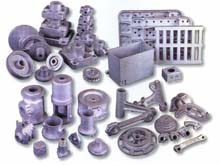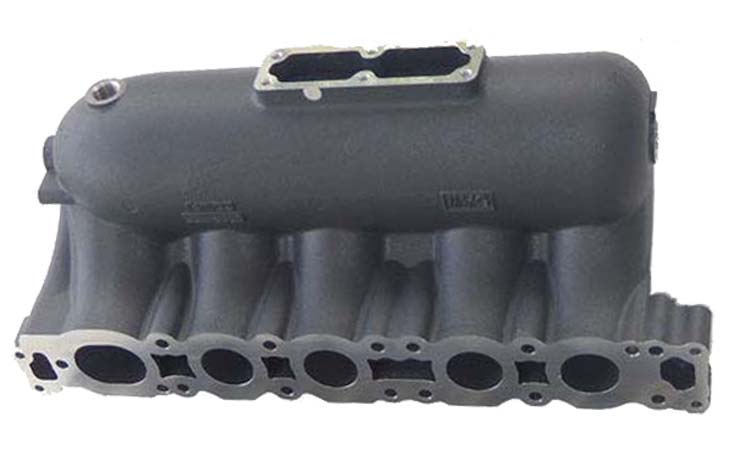Gravity casting
 Gravity Die Casting or permanent mould casting as the name suggests is a process wherein the liquid metal is poured into metallic moulds without application of any external pressure. The liquid metal enters the cavity by gravity. Gravity Die Casting is different from High Pressure Die Casting, where the liquid metal is injected into the metal mould under very high pressures for production of thin walled smaller castings with better dimensional accuracy and surface finish.
Gravity Die Casting or permanent mould casting as the name suggests is a process wherein the liquid metal is poured into metallic moulds without application of any external pressure. The liquid metal enters the cavity by gravity. Gravity Die Casting is different from High Pressure Die Casting, where the liquid metal is injected into the metal mould under very high pressures for production of thin walled smaller castings with better dimensional accuracy and surface finish.
In the design of dies for Gravity Die Casting, usage of “cores” is an important issue. The undercuts and the hollow shapes are produced with the help of additional mould parts called “cores”. For simple shapes without any under cuts the metallic cores could be used, whereas for undercuts and complex hollow shapes, which are difficult to retract, sand or plaster of paris cores are employed. The gravity die casting process is suitable for high volume production of non-ferrous alloy castings of Aluminium, Magnesium, Copper and Zinc base alloys and to limited extent for cast iron castings. Castings can be manufactured by operation of dies manually or by automatic devices or through die casting machines depending on the quantum of production.
The die materials used are gray cast iron and steels. Typical economical volume of production is around 75,000-1,00,000 pieces per die. After this the die wear causes component integrity to be lost. The economical volume of production of castings per die will be around 75,000 pieces.
The Gravity Die Casting process has several advantages. The process is suitable for mass production with better reproduction; dimensional accuracy and surface finish than conventional sand castings. A minimum wall thickness of 3.0 mm can be cast. Exceptionally, 2mm wall thickness is cast over small areas.
Castings ranging from few grams to ~100 Kgs of Aluminium alloy can be cast. There are reports of some foundries producing cylinder blocks of around 300 Kgs by Gravity Die Casting. As the component size and complexity increases the process becomes more expensive and becomes uneconomical. It will also cause difficulty in handling the die and in extracting the casting from the die with reduction in dimensional accuracy and soundness of the casting.
The Gravity Die Casting process is capable of achieving 20% higher mechanical properties than that of a sand casting because of faster rate of solidification imparting better grain size. The process can be automated and also can produce semi-gravity die-castings employing sand or plaster of paris cores for production of interior details.
The process has certain disadvantages. Limitation of geometry /size is a main disadvantage, as it is difficult to cast large size highly complex shapes. Beyond a particular shape and size the process becomes uneconomical. It is difficult to attach gates and risers at all desired locations. The casting yield is low when compared to other die casting process.
The process is not suitable for steels and super alloys, because of their high pouring temperatures. Even in non-ferrous alloys, it is difficult to cast alloys having tendency for hot tearing like Aluminium-Copper alloys. These alloys having long freezing ranges tend to crack under faster rate of solidification.
In Gravity Die Casting, the tooling costs are higher than that for sand castings and hence will be uneconomical for smaller production quantities. Tooling modifications can be expensive.
Aluminum gravity casting is one type of permanent mold casting. The melted aluminum alloy is pouring into permanent mold, and forming, then open the mold, get out the aluminum alloy aluminum gravity casting. The mold is made from cast iron or steel. If the part is complex, sometimes the foundry will make mold for cores. We can get good aluminum casting by the process. It is much stronger than sand casting and high pressure die casting.


 Sand Casting
Sand Casting Brake Disc Series
Brake Disc Series Brake Drum Series
Brake Drum Series Differential Cases
Differential Cases Featured Cases
Featured Cases Investment Casting
Investment Casting Cylinder End Mounts
Cylinder End Mounts Shaft Coupling
Shaft Coupling Cast Steel cable Protector
Cast Steel cable Protector Home Hardware Accessories
Home Hardware Accessories Featured Cases
Featured Cases Precision Machining
Precision Machining Hydraulic Piston
Hydraulic Piston Flange
Flange Featured Cases
Featured Cases Precision Stamping
Precision Stamping Featured Cases
Featured Cases Precision Forging
Precision Forging Featured Cases
Featured Cases Die Casting
Die Casting Featured Cases
Featured Cases Gravity casting
Gravity casting Featured Cases
Featured Cases Cold Forming
Cold Forming Featured Cases
Featured Cases Magnetic Assemblies
Magnetic Assemblies NdFeB Magnets
NdFeB Magnets Engineered Assemblies
Engineered Assemblies Magnetic Separators
Magnetic Separators Attraction Kits
Attraction Kits Powder Metal and Sintered Part
Powder Metal and Sintered Part Fokli Sourcing
Fokli Sourcing





 Gravity Die Casting or permanent mould casting as the name suggests is a process wherein the liquid metal is poured into metallic moulds without application of any external pressure. The liquid metal enters the cavity by gravity. Gravity Die Casting is different from High Pressure Die Casting, where the liquid metal is injected into the metal mould under very high pressures for production of thin walled smaller castings with better dimensional accuracy and surface finish.
Gravity Die Casting or permanent mould casting as the name suggests is a process wherein the liquid metal is poured into metallic moulds without application of any external pressure. The liquid metal enters the cavity by gravity. Gravity Die Casting is different from High Pressure Die Casting, where the liquid metal is injected into the metal mould under very high pressures for production of thin walled smaller castings with better dimensional accuracy and surface finish.